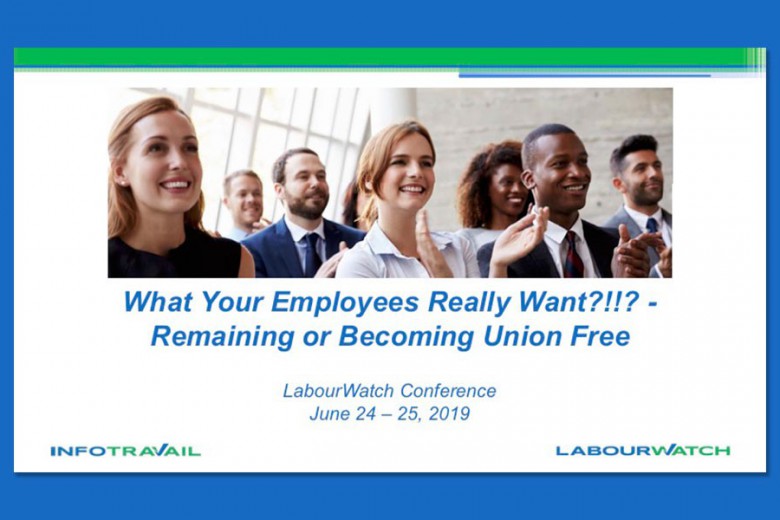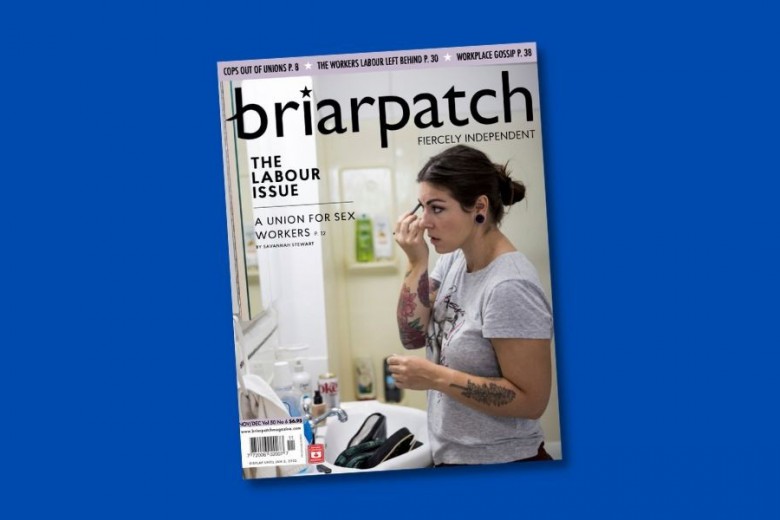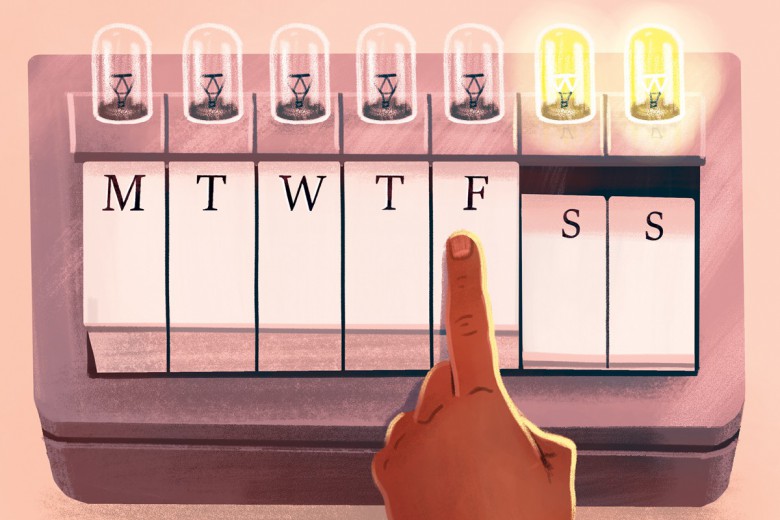Two teams negotiating behind closed doors. Media blackouts. Gruelling late-night sessions. The culture of secrecy around collective bargaining is well anchored in the public imagination.
But a growing number of unions in both Canada and the United States are bucking the historical trend, throwing the doors open to their full membership in a controversial approach known as open bargaining (or open negotiating). While some union activists cite pitfalls to opening up negotiations, resistance to the old-fashioned, closed-door process is growing in popularity. More unions are taking a chance on the new model, as they see the potential wins of opening negotiation – not just in collective agreements, but in building member engagement during a time of withering unionization rates.
Historically, the North American norm is that unions elect a small bargaining team (often only three or four members), which meets behind closed doors with their employer’s bargaining team over the course of several weeks or months. If the two sides reach an agreement, that tentative document is presented to the union’s membership to vote on, and this will typically be the first time most members set eyes on it. Open bargaining is defined differently by the various unions that use it, but the goal is to achieve greater transparency around the hitherto secretive bargaining process. In practice, this ranges from openly publishing the union’s negotiating proposals to allowing the entire union membership to sit in on negotiations.
Open bargaining practices range from openly publishing the union’s negotiating proposals to allowing the entire union membership to sit in on negotiations.
The stakes are high. According to Statistics Canada, unionization rates have fallen from 37.6 per cent in 1981 to 28.8 per cent in 2014. While the Canadian workforce is diversifying, union leaderships remain starkly white, cis, settler, and male, and union memberships are aging rapidly (between 1981 and 2012, unionization rates for the 25-to-44 age group dropped by over 11 percentage points). In the U.S., organized labour has been under legislative attack by state governments and courts through “right-to-work” laws designed to undermine unions’ resource and membership bases. In Canada, union solidarity has also been given short shrift – Canada’s largest private-sector union, Unifor, quit the Canadian Labour Congress in January and has commenced raiding a U.S.-headquartered international union, UNITE HERE, for members.
Given the grim backdrop, how important is the negotiation process, and how meaningful are the efforts of some unions to revolutionize that process? Labour scholars and activists have never agreed on what formulae are most likely to strengthen workers’ movements. But for many of the activists involved, opening up negotiations has had exciting results, ranging from better collective agreements to stronger relationships with the local community. Perhaps most importantly, experiencing change first-hand has been an empowering process for these activists, and one that’s strengthened their resolve to be creative and innovative in the struggle to improve workers’ rights.
Massachusetts: “The best contract that we’ve ever won”
Merrie Najimy is a kindergarten teacher in Concord, Massachusetts; she was also president of the Concord Teachers Association when it adopted an open negotiation model.
“I think it’s the most powerful way that we’ve ever bargained, and we won the best contract that we’ve ever won,” she says.
When her union entered negotiations in 2015, rather than asking their members for proposal ideas through typical bargaining surveys, they asked three simple questions.
“We framed it as ‘What brings you joy in the work you do with students?’, ‘What sucks the joy out of the work you do with students?’, and ‘What would you like to change through bargaining?’” says Najimy. “We always talk about what the problems are, and it’s hard to feel empowered when you only talk about the problems. When you start with your vision, it transforms how you begin to think about the problems and the solutions.”
“I think it’s the most powerful way that we’ve ever bargained.”
When it came time for negotiations, the union refused to accept the employer’s proposed ground rules to keep members out of negotiations. To force the point, they brought 50 members along to their third negotiating session.
Faced with a room full of members, the employer acceded and the two sides agreed they could both invite non-participating guests. The union brought members and parents of students; the employer brought managers and elected town officials. To their surprise, Najimy says, the union wound up winning over some of the elected officials.
“The public started to see that teachers are bargaining over things beyond money,” she explains. “We were bargaining over a reduction of testing, we were bargaining over teacher influence over curriculum and decisions. That was a winning argument in the community, and what that does is it changes the narrative about ‘the greedy teacher’ and it changes the narrative that the union exists just to protect that educator.”
“When they see the outrageous behaviour of the other side and the dignified behaviour of the teachers, as well as [our] visionary proposals, that’s where you win. When you are the visionaries and you are the leaders in public education, you win the public opinion.”
To their surprise, Najimy says, the union wound up winning over some of the elected officials.
What exactly do members do when they show up to an open bargaining session? That varies from union to union, but what was common to the unions I spoke with was allowing members to call for a caucus with their negotiating team whenever they want. If they hear misinformation being presented, they can call a caucus to advise their negotiating team. If an important point is being omitted, or if it appears the two sides don’t fully understand how a collective agreement clause plays out in real life, members can caucus to share that info. Or if they feel their negotiating team is making a serious mistake or concession, they can caucus to discuss.
An additional benefit, says Najimy, was that members kept each other updated on negotiations, spreading news faster than official union representatives could.
“So the members are experiencing themselves as the union, because they’re doing union work: members talking to members about negotiations.”
Toronto: “The number one reason we have strong collective agreements”
Megan Hillman is a member of CUPE 3903, the union representing teaching assistants and contract faculty at York University in Toronto. She served on the bargaining team in 2011. While the union has been on strike four times since she became a member, she credits its adherence to the open negotiation model – all negotiating meetings are open to any member to attend – as the reason it has one of the strongest contracts (in terms of wages and benefits) in the sector.
“It means that we have a membership who has ownership over our proposals, and who are invested in things that they may not otherwise have a personal connection to,” she explains.
She cites the union’s recent demands for breastfeeding facilities on campus. When members heard first-hand from other members affected by the issue, this turned a largely ignored equity issue into a focal point for rallies, petitions, and even a “lactation-in” protest and march to the president’s office on campus.
“It means that we have a membership who has ownership over our proposals.”
Receiving personalized bargaining updates from colleagues who were present strengthens the relationship between the bargaining team and the membership, she feels.
“One of the things about [closed] bargaining itself is [the bargaining team] can get very closed off from the membership, and really conservatized by the process, where all of a sudden that 0.5 per cent wage increase does sound reasonable,” she says.
In addition to strengthening the union’s ability to identify hidden concessions in the employer’s proposals, Hillman feels having a diverse membership in the room renders equity issues like race and gender more prominent and personal; the process keeps them on the agenda more effectively than closed-door negotiating, especially while union leaderships are still predominantly white and male.
“When you are trying to bargain improvements to equity language, it can be very important and very helpful to have a room full of equity seekers,” she says, “so that the employer has to face people, and say ‘No, we don’t think you, as a Black woman, should have more right to a position than the white man.’ Or to say ‘No, we don’t need to make the university more accessible,’ to a room of people with mobility devices, who couldn’t get into the room. When the employer has to face the people that they are saying no to, it gets harder to say no.”
Open, big, and representative bargaining
The experience these unions have had with open negotiating has been positive. Why, then, do relatively few unions use the model? Apart from simply not knowing about it, some activists perceive a sense of mistrust between union leadership and general membership.
Jane McAlevey is a labour scholar and union activist who’s been outspoken in calling for unions to open up negotiations, a process she’s honed through working with several unions. When she gives presentations about open bargaining, she says she’s shocked by how many union officers worry that workers will “get out of control” if invited to negotiating sessions.
“Too many officials have very little faith in the intelligence of ordinary workers who could be involved in the union,” she notes. “They’ll just say to me ‘How did you control everybody?’ It’s always about control. […] It’s actually just not my experience that this is a problem.”
“What open negotiations is not, is chaos. What it is, is incredibly highly disciplined.”
“Too many officials have very little faith in the intelligence of ordinary workers who could be involved in the union.”
McAlevey’s approach involves “three rules” for union members attending negotiations: (1) no one talks except the chief negotiator, unless it’s planned; (2) poker face at all times; (3) any member can call a caucus with the negotiating team by passing a note to them. (A fourth, unofficial rule she’s had to add more recently is: no use of cellphones or social media during negotiating sessions.) She feels open negotiations are “the single best vehicle to build a high-participation union” – an imperative in an era in which unions are under threat.
“It’s a way of actually saying to the rank and file, ‘We trust you. We think you’re smart. We think you should be involved in the single biggest decision that a union […] is engaged in,’” she says.
Organizing is about more than just negotiations
Nora Loreto is an editor with the Canadian Association of Labour Media and author of From Demonized to Organized: Building the New Union Movement. She warns that while negotiations are important, too many unions wait until negotiation time to actively engage with their members.
“People need to not romanticize [the bargaining] so much,” she says. “You cannot have a community approach to bargaining if you don’t have community connections outside of bargaining. So you have to start outside bargaining, you have to make sure that your union members are not discovering the union during a moment of crisis.”
Loreto cautions that just because bargaining is open doesn’t mean it’s accessible. “We have to also be realistic about who has the amount of time to sit through endless meetings, and is it really more democratic if you’re just opening up the doors to meetings? […] Are you mobilizing people in the hallways, or is your open bargaining meeting literally the same one hundred people?”
“Is it really more democratic if you’re just opening up the doors to meetings?”
She also points out that there are other ways to be open in negotiating. This can mean brokering workplace policies that protect both union and non-union workers, like health and safety protocols (workplace-wide negotiating can also be a way to push back against privatization, she notes). It can mean developing ways to force the employer to be more active in the community, through designating funds for community improvement, scholarships, or public events.
“When we think about open bargaining, what we really mean is, how do we use the collective power of one group of workers to extend similar kinds or different kinds of new powers or protections to other workers?”
Messy or disciplined?
Not all union activists are sold on the model of open bargaining. Hillman, an advocate of open negotiation, admits “it can be a bit slow and it can be a bit messy and it can be a bit chaotic.”
Jessica Wender-Shubow is president of the Brookline Educators Union in Massachusetts, another union that is moving toward open negotiation. She’s a supporter, but she’s faced arguments against the model.
“The concern about open bargaining is it all becomes about posturing,” she says, acknowledging it can undermine the negotiating team’s ability to compromise with the employer on issues. The public gaze may make either side feel pressured to act tough. For some activists, that pressure to not compromise is one of the benefits of open negotiating. Others worry it could pose a barrier to meaningful dialogue.
Wender-Shubow’s response is that building relationships with union members, and allowing for accountability and transparency is worth the risk and outweighs any possible negatives.
Najimy points out that the open negotiation model shifts the discussion about who has power in the union.
“The old union model is [one where] the power lies in the [union] president and the president’s relationship with the employer, and that we need to keep things under tight control so the message doesn’t get away from us. But we don’t win good contracts like that.”
“The public gaze may make either side feel pressured to act tough.”
Under the old model, she observes, members don’t know what’s happening until they’re presented with a tentative agreement to vote on. This can generate resentment toward the union and its negotiating team if members don’t like what they negotiated. But when members have been able to follow the process, “people felt that they did the work that it took to win it and they got what they were expecting.”
McAlevey doesn’t mince words: “The less people see, the easier it is for you to go cut deals, and do bad things. And I think that’s on both sides.”
For her, what it comes down to is building a highly mobilized, participatory union.
“You need to be able to say, ‘If we put out a flyer for a rally […] can you get 75 per cent of the rank and file to show up?’ If you can do that without shifting to an open negotiations process, congratulations. I’ve never seen it. I’ve only experienced getting to massive turnouts and massive high participation by opening up the negotiations process and showing workers that we don’t win without your participation.”
Negotiating across borders
While there are Canadian unions using open negotiating models, much of the recent momentum is coming from American labour organizations. Could the openness of American unions toward the model be less about renewal and radicalism, and more about a last-ditch effort to save themselves?
“One thing that I think Canadian activists don’t really get is that a lot of the radical action that we’re seeing in the United States is coming out of a place of complete desperation,” says Loreto. “It’s their only option.”
Loreto says Canadian unions still have a range of tools at their disposal – money, collective agreements, strong public institutions like public health care – that American unions no longer have. The demise of American public institutions at the hands of capital has led to a greater sense of despair in that country, she says.
“We can’t replicate desperation,” she says. “We are confronting capital in a different way. [In Canada] it takes a lot more strategy, it takes a lot more building on the ground to make sure that your membership is ready to take radical action, because a lot of the injustices are a lot harder to see.”
“We can’t replicate desperation. We are confronting capital in a different way.”
But it isn’t always leftists who champion open meetings. In other cases, American right-wing organizations, who seek to undermine the strength of collective bargaining, promote open meeting policies as regional ballot-measures. They argue that the “tax-paying public” should have the right to scrutinize negotiations. Yet even these measures may have the unintended side effect of strengthening unions’ popular support, some observers suggest. And some provincial and municipal governments, for instance in British Columbia, enact open meeting policies on principles of transparency and open government.
McAlevey, who’s worked with both Canadian and American unions, puts less stock in differences between the two countries. While it’s true that the Canadian labour relations regime has been better protected by Supreme Court rulings in Canada than its American counterpart, which has seen “right-to-work” laws and other anti-union legislation steadily erode unions’ institutional power in that country, she feels the differences are illusory.
She reminds Canadians that politicians like former Conservative prime minister Stephen Harper and former Toronto mayor Rob Ford led concerted attacks on the rights of unions. She says during the eight years of relative labour peace under former Democratic president Barack Obama, American unions became complacent and overconfident, and failed to make up for the losses they’d suffered under his Republican predecessors. She worries a similar sentiment now pervades Canadian unions under the federal Liberal government of Prime Minister Justin Trudeau.
McAlevey fears Canadian unions are making the same mistakes now that American unions made in the early 2000s.
“[Unions] are missing the opportunity to make the kind of demands on the Trudeau government that we need to be making to fix and undo things that Harper was doing,” she cautions. “I fear that Canadians might be doing what a lot of unions did here, which is missing an opportunity while there’s safety around – meaning there isn’t a union-buster in that top position – to actually do the rebuilding of our unions while it’s sort of a safe space to do it.”
McAlevey feels that Canada is only a few years behind the U.S. when it comes to the erosion of labour rights and public institutions, and that without a serious change in course its unions will share the fate of their southern counterparts. She fears Canadian unions are making the same mistakes now that American unions made in the early 2000s: failing to experiment with new methods of organizing and negotiating, and failing to co-operate with each other in meaningful ways. She points to the recent division in the Canadian Labour Congress as an example.
“I have a fear for Canada,” she says. “There has been a consistent nibbling, if not full bites, taking place province by province, against workers’ rights in Canada.”
“What Canadians do, I think to your detriment, is compare yourselves to the U.S.,” she says. “Well, of course anywhere would look better than the U.S. right now! I always say to people, don’t compare yourselves to here! That’s the wrong comparison. Compare yourself to your own self 30 years ago. Do your own analysis of how many rights have been taken away.”
“What I’m seeing now makes me very nervous for the Canadian context.”







